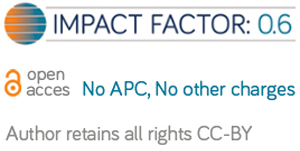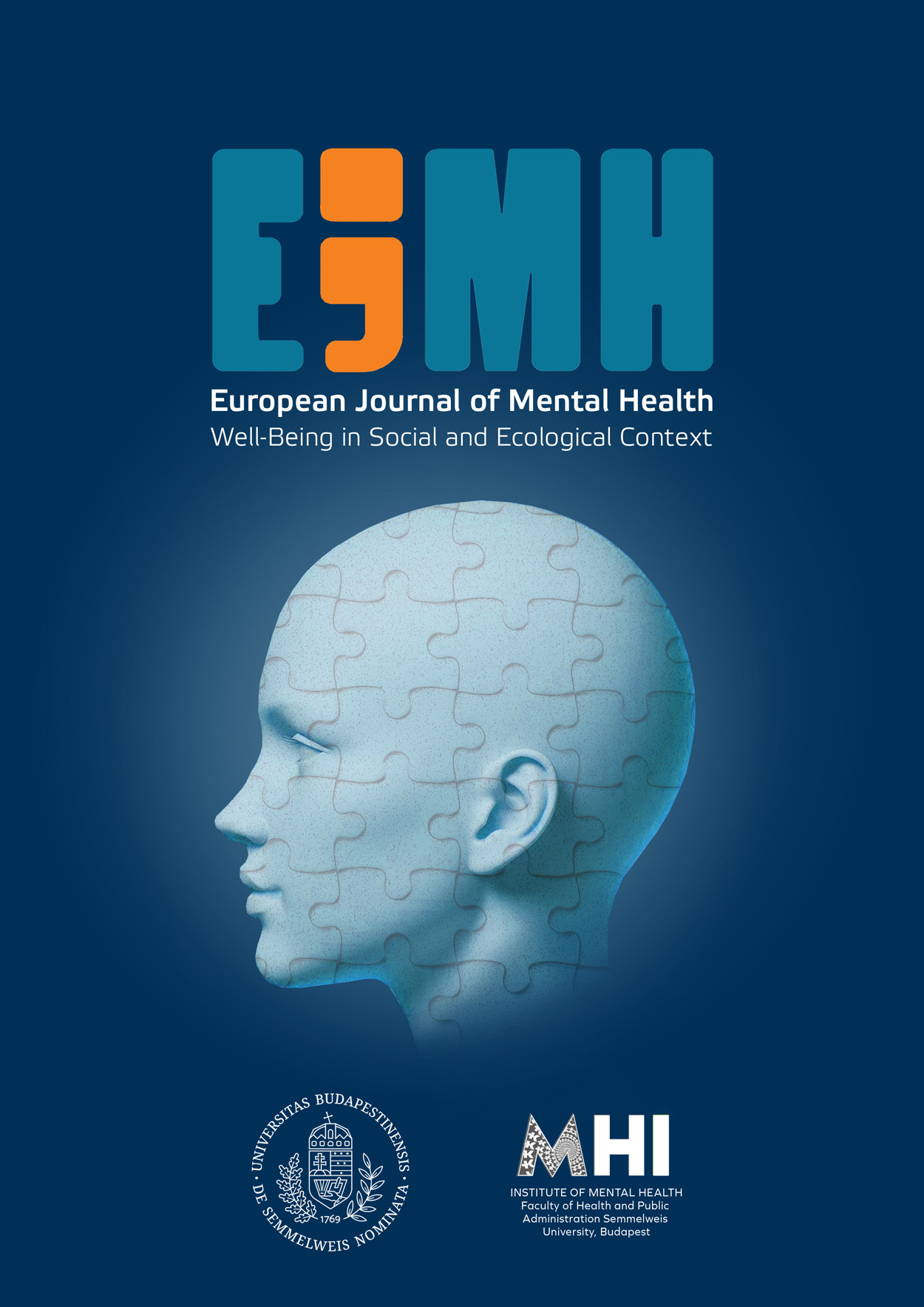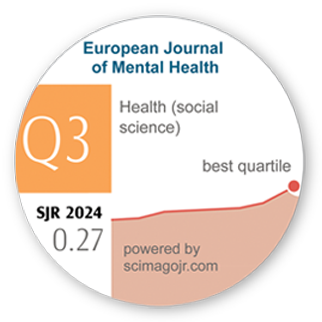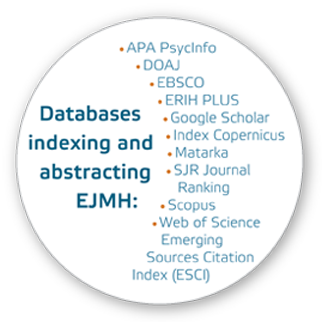“Performing Emotions and Suffering.” Recovery of Depressive Symptoms Involving Adolescent Intervention in Art and Dance Schools
DOI:
https://doi.org/10.5708/EJMH.17.2022.3.5Keywords:
mental health, prevention, suicide, adolescents, art schoolsAbstract
Introduction: In previous studies, a large majority of dance students reported mental health issues, mainly eating disorders and depression.
Aims: This project aimed to promote mental health and well-being as well as prevent maladaptive and risky behaviors – namely suicidal behavior – among adolescents who attend art and dance schools. It was implemented in sequential stages, including six moments of classroom intervention for adolescents.
Methods: A quasi-experimental research design was applied, with two assessment moments (before and after the intervention) using questionnaires filled out by the adolescents.
Results: The project was implemented in three art schools (Center and South of Portugal), and the sample consisted of 122 adolescents. 72.9% of our sample were girls aged 12–18 years (M = 13.88; SD = 1.54). Boys showed significantly higher well-being scores (M = 16.53; SD = 4.24 vs M = 14.67, SD = 4.17), and girls showed higher coping scores (M = 153.3; SD = 13.53 vs M = 146.73; SD = 13.22). Concerning depressive symptoms, 34.8% of adolescents had moderate/severe depressive symptoms, which decreased by 10% after the intervention.
Conclusions: Adolescents attending art schools might be more vulnerable to developing mental distress, and this intervention proved to be an effective approach for promoting mental health and well-being as well as preventing suicidal behaviors.
References
Beck, A., & Steer, R. (1987). Manual for the beck depression inventory. Psychological Corporation.
Bidik, G., & Sisman, F. (2021) School-based mental health programs for improving psychosocial well-being in children and adolescents: Systematic review. Journal of Psychiatric Nursing, 12(4), 350–361.
http://doi.org/10.14744/phd.2021.14471
Centers for Disease Control and Prevention. (2017). WISQARS. Web-based injury statistics query and reporting system.
https://www.cdc.gov/injury/wisqars/fatal_injury_reports.html
Callahan, P., Liu, P., Purcell, R., Parker, A., & Hetrick, S. (2012). Evidence map of prevention and treatment interventions for depression in young people. Depression Research and Treatment, 2012, Article 820735.
https://doi.org/10.1155/2012/820735
Direção Geral da Saúde (2013). Programa nacional para a saúde mental - Plano nacional de prevenção do suicídio 2013/2017 [National program for mental health - National plan for suicide prevention 2013/2017].
https://www.dgs.pt/documentos-e-publicacoes/plano-nacional-de-prevencao-do-suicido-20132017-pdf.aspx
Direção Geral da Saúde (2015). Norma n.º 015/2015 de 12/08/2015, Programa nacional de saúde escolar 2015 [Regulation no. 015/2015 of 12/08/2015, National program for school health 2015].
https://www.dgs.pt/directrizes-da-dgs/normas-e-circulares-normativas/norma-n-0152015-de-12082015-pdf.aspx
Erse, M., Simões, R., Façanha, J., Marques, L., Loureiro, C., Matos, M., & Santos, J. (2016). Adolescent depression in schools: +Contigo Project. Revista de Enfermagem Referência, 4(9), 37–44.
http://doi.org/10.12707/RIV15026
Esparbès, S., Sordes-Ader, F., & Tap, P. (1993). Présentation de l’échelle de coping [Presentation of the coping scale]. In Les stratégies de coping (pp. 89–107). Journées du Labo PCS, 93. St Criq (Actes).
Grove J., Main L., & Sharp L. (2013). Stressors, recovery processes, and manifestations of training distress in dance. Journal Dance Medicine and Science,17(2), 70–78.
Gil, I., Santos, J., & Loureiro, L. (2016). Estigma em estudantes de enfermagem: antes e depois do contacto com pessoas com transtornos mentais [Stigma in nursing students: Before and after contacting with people with mental disorders]. UERJ Nursing Journal, 24(1), Article e12309.
https://doi.org/10.12957/reuerj.2016.12309
Iosue, M., Carli, V., D’Aulerio, M., Basilico, F., Di Domenico, A., Recchia, L., Wasserman, C., Hoven, C., Sarchiapone, M., & Wasserman, D. (2012). Depression and suicidal ideation among Italian adolescents: Preliminary results from the SEYLE project. European Psychiatry, 27(1), 1–1.
https://doi.org/10.1016/S0924-9338(12)75593-1
Johansen, K. S. (1989). World Health Organization multicentre continuous subcutaneous infusion pump feasibility and acceptability study experience. WHO.
Landis, J. R., & Koch, G. G. (1977). The measurement of observer agreement for categorical data. Biometrics, 33(1), 159–174.
https://doi.org/10.2307/2529310
Mainwaring, M., Krasnow, D., & Kerr, G. (2001). And the dance goes on: Psychological impact of injury. Journal of Dance Medicine and Science 5(4), 105–115.
http://www.citraining.com/pdfs/Psychological-Impact-of-Injury.pdf
Mainwaring, L. M., & Finney, C. (2017). Psychological risk factors and outcomes of dance injury. A systematic review. Journal of Dance Medicine and Science, 21(3), 87–96.
https://doi.org/10.12678/1089-313x.21.3.87
Martins, A. (2000). As manifestações clínicas da depressão na adolescência [Clinical manifestations of depression in adolescence] [Master’s thesis, Universidade do Porto]. FMUP-Dissertacao.
https://hdl.handle.net/10216/10115
Mathisen, F., Sundgot-Borgen, C., Anstensrud, B., & Sundgot-Borgen, J. (2022). Mental health, eating behaviour and injuries in professional dance students. Research in Dance Education, 23(1), 108–125.
https://doi.org/10.1080/14647893.2021.1993171
Moksnes, U. K., Eilertsen, M. E. B., & Lazarewicz, M. (2016). The association between stress, self-esteem and depressive symptoms in adolescents. Scandinavian Journal of Psychology, 57(1), 22–29.
https://doi.org/10.1111/sjop.12269
Monthuy‑Blanc, J., Mariano C., & Therme P. (2010). Prevalence of eating disorders symptoms in no elite ballet dancers and basketball players: An exploratory and controlled study among French adolescent girls. Revue d’Épidémiologie et de Santé Publique, 58(6), 415–424. https://doi.org/10.1016/j.respe.2010.07.003
Muehlenkamp, J. J., Claes, L., Havertape, L., & Plener, P. L. (2012). International prevalence of adolescent non-suicidal self-injury and deliberate self-harm. Child and Adolescents Psychiatry and Mental Health, 6, Article 10.
https://doi.org/10.1186/1753-2000-6-10
Murray, K., Rieger, E., & Byrne, D. (2013). A longitudinal investigation of the mediating role of self-esteem and body importance in the relationship between stress and body dissatisfaction in adolescent females and males. Body Image, 10(4), 544–551.
https://doi.org/10.1016/j.bodyim.2013.07.011
Nock, M., Green, J., Hwang, I., McLaughlin, K., Sampson, B., Zaslavsky, A. M., & Kessler, R.C. (2013). Prevalence, correlates, and treatment of lifetime suicidal behavior among adolescents: Results from the National Comorbidity Survey Replication Adolescent Supplement. JAMA Psychiatry, 70(3), 300–310.
https://doi.org/10.1001/2013.jamapsychiatry.55
Picazo-Zappino, J. (2014). Suicide among children and adolescents: a review. Actas Españolas de Psiquiatría, 42(3), 125–132.
https://www.actaspsiquiatria.es/repositorio//16/89/ENG/16-89-ENG-125-132-712041.pdf
Piers, E., & Herzberg, D. (2002). Piers-Harris 2: Piers-Harris Children’s Self-Concept Scale (2nd ed.). Western Psychological Services.
Polanczyk, G. V., Salum, G A., Sugaya, L. S., Caye, A., &. Rohde, L. (2015). Annual research review: A meta-analysis of the worldwide prevalence of mental disorders in children and adolescents. The Journal of Child Psychology and Psychiatry, 56(3), 345–365.
https://doi.org/10.1111/jcpp.12381
Ricciardelli, L. A., & McCabe, M. P. (2002). Psychometric evaluation of the body change inventory: An assessment instrument for adolescent boys and girls. Eating Behaviours, 3(1), 45–59.
https://doi.org/10.1016/S1471-0153(01)00044-7
Santos, J. C. (Coord.), Erse, M. P. Q. A., Façanha, J. D. N., Marques, L. A. F., & Simões, R. M. P. (2014). +Contigo: Promoção de saúde mental e prevenção de comportamentos suicidários na comunidade educativa [+Contigo: Mental health promotion and prevention of suicide behaviors in the school community]. Série Monográfica, 9. Escola Superior de Enfermagem de Coimbra.
Scott, A., & Guo, B. (2012). For which strategies of suicide prevention is there evidence of effectiveness? HEN synthesis report. WHO Regional Office for Europe.
http://www.euro.who.int/__data/assets/pdf_file/0005/169466/E96630.pdf
Simões, R. M. P., Santos, J. C. S., Façanha, J, Erse, M., Loureiro, C., Marques, Quaresma, M., & Matos, E. (2018). Promoção do bem-estar em adolescentes: contributos do projeto +Contigo [Promoting well-being in adolescents: The +Contigo project]. Portuguese Journal of Public Health, 36(1), 41–49.
https://doi.org/10.1159/000486468
Stice, E., & Shaw, H. (2002). Role of body dissatisfaction in the onset and maintenance of eating pathology: A synthesis of research findings. Journal of Psychosomatic Research, 53(5), 985–993.
https://doi.org/10.1016/s0022-3999(02)00488-9
Tap, P., Costa, E., & Alves, M. (2005). Escala Toulousiana de Coping (ETC) - Estudo de adaptação à população Portuguesa [Toulouse Coping Scale – Adaptation study to the Portuguese population]. Psicologia, Saúde e Doenças, 6(1), 47–56.
Tavares, G. M. (2013). Atlas do corpo e da imaginação: Teoria, fragmentos e imagens [Body and imagination atlas: Theory, fragments, and pictures]. Editorial Caminho.
Thomas, J., Keel, P., & Heatherton T. (2011). Disordered eating and injuries among adolescent ballet dancers. Eating and Weight Disorders-Studies on Anorexia, Bulimia and Obesity, 16(3), 216–222.
https://doi.org/10.1007/BF03325136
Veiga, F. (2006). Uma nova versão da escala de autoconceito Piers-Harris children’s selfconcept scale (PHCSCS-2) [A new version of the Piers-Harris children’s self-concept scale (PHCSCS-2)]. Psicologia e Educação, 5(1), 39–48.
http://hdl.handle.net/10451/4672
Venta, A., & Sharp, C. (2014). Attachment organization in suicide prevention research: Preliminary findings and future directions in a sample of inpatient adolescents. Crisis: The Journal of Crisis Intervention and Suicide Prevention, 35(1), 60–66.
https://doi.org/10.1027/0227-5910/a000231
Vedana, K. G. G., dos Santos, J. C., Zanetti, A. C. G., Miasso, A. I., Ventura, C. A. A., Pillon, S. C., de Souza, J., & Silva, A. C. (2020). Attitudes of Portuguese nursing undergraduate students toward suicidal behaviour. British Journal of Mental Health Nursing, 9(1), 41–49.
http://dx.doi.org/10.12968/bjmh.2018.0031
Winden, D., Rijn, R., Savelsberg, G., Oudejand, R., & Stubbe, J. (2020). Characteristics and extent of mental health issues in contemporary dance students. Medical Problems of Performing Artists, 35(3), 121–129.
https://doi.org/10.21091/mppa.2020.3019
World Health Organization. (2008, June 12–13). European pact for mental health and well-being. EU High- Level Conference. Together For Mental Health and Well-Being, Brussels, Belgium.
https://ec.europa.eu/health/ph_determinants/life_style/mental/docs/pact_en.pdf
World Health Organization. (2010a). Global recommendations on physical activity for health.
https://www.who.int/publications/i/item/9789241599979
World Health Organization. (2010b). Child and adolescent health and development: progress report 2009: highlights.
https://apps.who.int/iris/handle/10665/44314
World Health Organization. (2014a). Preventing suicide: A global imperative.
https://www.who.int/publications/i/item/9789241564779
World Health Organization. (2014, September 15–18). Investing in children: the European child and adolescent health strategy 2015–2020. Regional Comittee for Europe, 64th session, Copenhagen, Denmark.
http://www.euro.who.int/__data/assets/pdf_file/0010/253729/64wd12e_InvestCAHstrategy_140440.pdf
World Health Organization. (2017). Disease and injury country mortality estimates, 2000–2015 [Data set]. Global Health Observatory.
https://www.who.int/data/gho/data/themes/mortality-and-global-health-estimates/ghe-leading-causes-of-death
World Health Organization. (2019). Suicide in the world: global health estimates.
https://apps.who.int/iris/handle/10665/326948
World Health Organization. (2022). World mental health report: transforming mental health for all.
https://www.who.int/publications/i/item/9789240049338






